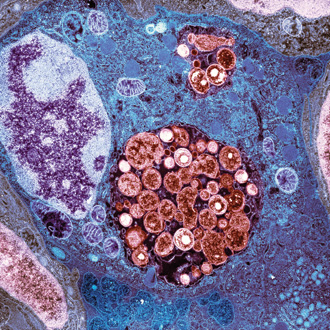The case
During the summer, a 35-year-old male non-smoker presents to his GP with a one-week history of fever, headache, arthralgia and subsequent dry cough. However, over the last two days he has felt increasingly short of breath on exertion. A temperature of 38.7°C is recorded. Abnormal examination findings are confined to the respiratory system, where a respiratory rate of 28 breaths per minute is recorded and the presence of bilateral inspiratory crepitations is noted on auscultation. The CRB-65 score is 0. Pulse oximetry records oxygen saturations of 95% on room air.
A diagnosis of community-acquired pneumonia is made and the patient is started on amoxicillin 500mg tds in accordance with BTS guidelines.
The patient returns four days later, increasingly short of breath with a respiratory rate of 35 breaths per minute. The patient volunteers that he has been looking after a friend’s parakeet while they are on holiday, which has become lethargic with ruffled feathers, and he questions if this could be related to his symptoms. The GP suspects the patient has psittacosis and refers him for assessment in hospital, where the diagnosis is confirmed.
The problem
Psittacosis – also known as parrot fever or ornithosis – is a rare condition caused by Chlamydophila psittaci (formerly Chlamydia psittaci); obligate intracellular gram-negative bacteria commonly found in birds. In the UK, there are around 50 laboratory-confirmed cases per year, but since symptoms may be absent or mild and the diagnosis not always considered, this number probably represents an underestimate of the true prevalence. Occasionally, outbreaks related to bird fairs, poultry processing plants or pet shops occur, which should prompt the primary care team to consider the diagnosis in patients with typical symptoms.
Features
Infection occurs through inhalation of bacteria shed in faeces, respiratory secretions or bacteria present on feather dander of infected birds. Bacteria can remain viable for several months in faeces, which perhaps explains why a history of exposure is not always evident.2 The incubation period may be as short as five days or as long as one month.
Typical psittacosis symptoms include:
– Abrupt onset of fever.
– Headache.
– Myalgia.
– Arthralgia.
– Fatigue.
– Non-productive cough.
Shortness of breath may also be present, and in some cases respiratory failure may be severe, or even fatal. Patients may also complain of diarrhoea. On rare occasions Cp. psittaci can cause myocarditis, endocarditis, hepatitis or meningoencephalitis.
Diagnosis
As psittacosis is a rare zoonosis, which typically presents with influenza-like symptoms, the key to diagnosis is establishing a history of exposure to birds. This may be through keeping birds as pets or through the individual’s occupation, including working in a pet shop, abattoir, poultry processing factory or zoo, working as a farmer, veterinarian, or with wildlife. Although Cp. psittaci is typically associated with birds from the parrot family, it can be found in many species of domesticated or wild birds, which may otherwise appear healthy. Shedding of bacteria may also be intermittent, and precipitated by stressors such as transportation or relocation. Patients requiring admission are likely to have abnormal findings on respiratory examination or a chest radiograph, but the leukocyte count is usually within normal range. Once the diagnosis is suspected, it should be confirmed serologically with paired acute and convalescent serum samples taken two weeks apart. Testing by polymerase chain reaction is possible but generally unavailable.
Management
Prior to antibiotics being available, mortality in symptomatic patients was 15-20%, but now with correct treatment most patients will recover. Tetracyclines are the first choice (doxycycline 200mg as a loading dose, then 100mg daily) and should be initiated once the diagnosis is suspected.3 Macrolides such as clarithromycin 500mg bd may be used as alternatives. Resolution of fever typically occurs within 48 hours of treatment. This is clinically helpful as serological confirmation is obtained with a convalescent sample, and antibody titres may be diminished by antibiotics.
Although not a notifiable disease, Cp. psittaci is a notifiable organism, and should be reported by the diagnostic laboratory to the Health Protection Agency (HPA) within 24 hours. The primary care team may be contacted for additional information as the patient could represent part of an outbreak. Birds with probable infection are usually destroyed or treated by a vet. The HPA may also implement control measures in a workplace.
Key points
– Psittacosis is difficult to diagnose, and exposure to birds or their droppings is a key feature
– Birds can be healthy and still cause human disease
– Cases may represent part of an outbreak
– Correct treatment usually results in recovery
Dr Matt P Wise is a consultant in adult critical care at the University Hospital of Wales, Cardiff.
Dr Matt PG Morgan is a clinical lecturer at the School of Medicine, Cardiff University.
References
1 Public Health England. Background information on psittacosis. London; PHE: 2014
2 Smith KA, Bradley KK, Stobierski MG et al. Compendium of measures to control Chlamydophila psittaci (formerly Chlamydia psittaci) infection among humans (psittacosis) and pet birds, 2005. Am Vet Med Assoc, 2005;15;226:532-9
3 Lim WS, Baudouin SV, George RC et al. BTS guidelines for the management of community-acquired pneumonia in adults: update 2009. Thorax, 2009;64:iii1-55

















